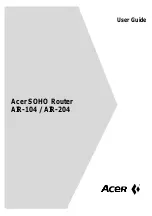
7. GLOSSARY AND ACRONYMS
7. Glossary and Acronyms
Backup Routes
Allows user to back up the pri-
mary connection with alternative connections to
the Internet/mobile network. Each backup con-
nection can have assigned a priority. Switching
between connections is done based upon set pri-
orities and the state of the connections.
DHCP
The Dynamic Host Configuration Proto-
col (DHCP) is a network protocol used to con-
figure devices that are connected to a network
so they can communicate on that network using
the Internet Protocol (IP). The protocol is imple-
mented in a client-server model, in which DHCP
clients request configuration data, such as an IP
address, a default route, and one or more DNS
server addresses from a DHCP server.
DHCP client
Requests network configuration
from
DHCP server
Answers configuration request by
and sends network configuration
details.
DNS
The Domain Name System (DNS) is a hi-
erarchical distributed naming system for comput-
ers, services, or any resource connected to the
Internet or a private network. It associates var-
ious information with domain names assigned
to each of the participating entities. Most promi-
nently, it translates easily memorized domain
names to the numerical IP addresses needed
for the purpose of locating computer services
and devices worldwide. By providing a world-
wide, distributed keyword-based redirection ser-
vice, the Domain Name System is an essential
component of the functionality of the Internet.
DynDNS client
DynDNS service lets you ac-
cess the router remotely using an easy to re-
member custom hostname. This client monitors
the router’s
and updates it whenever
it changes.
GRE
Generic Routing Encapsulation (GRE) is
a tunneling protocol that can encapsulate a wide
variety of network layer protocols inside virtual
point-to-point links over an Internet Protocol net-
work. It is possible to create four different tun-
nels.
HTTP
The Hypertext Transfer Protocol (HTTP)
is an application protocol for distributed, collab-
orative, hypermedia information systems. HTTP
is the foundation of data communication for the
World Wide Web.
Hypertext is structured text that uses logi-
cal links (hyperlinks) between nodes containing
text. HTTP is the protocol to exchange or transfer
hypertext.
HTTPS
The Hypertext Transfer Protocol Secure
(HTTPS) is a communications protocol for se-
cure communication over a computer network,
with especially wide deployment on the Inter-
net. Technically, it is not a protocol in and of it-
self; rather, it is the result of simply layering the
Hypertext Transfer Protocol (HTTP) on top of the
SSL/TLS protocol, thus adding the security ca-
pabilities of SSL/TLS to standard HTTP commu-
nications.
IP address
An Internet Protocol address (IP
address) is a numerical label assigned to each
device (e.g., computer, printer) participating in
a computer network that uses the Internet Pro-
tocol for communication. An IP address serves
two principal functions: host or network inter-
face identification and location addressing. Its
role has been characterized as follows:
A name
indicates what we seek. An address indicates
where it is. A route indicates how to get there
120
Содержание B+B SmartWorx LR77 v2
Страница 1: ...Configuration Manual for v2 Routers ...
Страница 18: ...2 STATUS WiFi Scan output may look like this Figure 4 WiFi Scan 11 ...
Страница 29: ...3 CONFIGURATION Figure 12 Example 1 LAN Configuration Page 22 ...
Страница 34: ...3 CONFIGURATION Figure 19 Example of VRRP configuration backup router 27 ...
Страница 42: ...3 CONFIGURATION Figure 20 Mobile WAN Configuration 35 ...
Страница 50: ...3 CONFIGURATION Figure 24 WiFi Configuration 43 ...
Страница 75: ...3 CONFIGURATION Figure 36 IPsec Tunnels Configuration 68 ...
Страница 105: ...3 CONFIGURATION Figure 54 Expansion Port Configuration 98 ...
Страница 110: ...3 CONFIGURATION Figure 59 Example 2 USB port configuration 103 ...









































